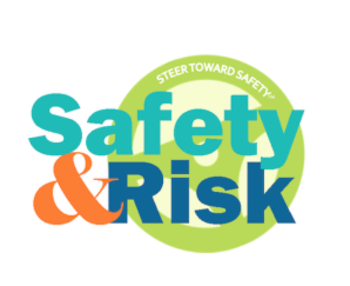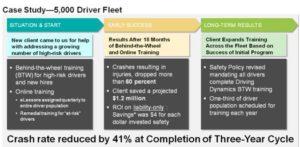
By Erik Bousquet, Behind-the-Wheel Driver Safety Instructor at Driving Dynamics
Fleet operators today face the daunting task of mitigating risk in a tough economic environment. Recent analyses continues to show an uptick in the number of traffic crashes. What is needed to get control over these escalating costs?
Organizations that employ drivers have a responsibility to ensure those employees are equipped with the highest level of skill and knowledge when it comes to: handling their vehicles, understanding the use and limitations of vehicle safety technologies, safely carrying loads and managing external influences effectively.
Equally important is sustaining responsible attitudes and behaviors toward safety behind-the-wheel. Consider that most fleet drivers have been driving for several, if not many, years and those years on the road represent the preponderance of their driving education. In other words, when comparing the time invested in any formal drivers’ education licensing training with their post-licensing time on the road, drivers are largely self-taught. And what have they learned?
Unfortunately, over time, drivers can develop sub-standard operational patterns and behaviors that put them at risk. As time goes by without incident, or very minor upsets, drivers can conclude that their actions behind the wheel indicate that they are above average drivers, when in fact, quite the opposite is probably true. Those individuals have become unconscious incompetents and continue down a dangerous path of reinforcing at-risk actions and behavior.
A meaningful model for driving excellence is based on a comprehensive driver safety study performed in Europe by the University of Turku Traffic Research Department. [click to enlarge]
In the chart, vehicle control is presented as the foundation for attaining driving excellence; however, history shows most drivers have built this foundation with their self-taught post-licensing driving experiences. It is critically important for fleet operators to assure that the performance levels of their drivers are derived from successful, proven safety practices. Anything less shows up in increased crash frequency, employee turnover, increased health care costs, lost time (or worse), and lawsuits.
To continue improvements in driver safety performance, employers must also provide opportunities to learn, practice and perfect capabilities in:
- Situational Awareness
- Sound Decision Making
- Awareness and Understanding of At-Risk Behaviors and Attitudes
To achieve levels of excellence, fleet drivers should regularly engage in advanced performance driver safety training and coaching. Various factors can determine the types of training and coaching in which drivers should participate. Factors can include job tenure (e.g., new hires are traditionally a high-risk group), geographical conditions, vehicle types, and driver risk categorization based on traffic violations, telematics, crashes, etc.
As recommended by the Network of Employers for Traffic Safety (NETS)1, all drivers in an organization should be cycled through a combination classroom and behind-the-wheel (BTW) courses to ensure that their driving capabilities (vehicle control, defensive operation, situational awareness, and more) are brought up to solid safety performance standards. NETS also recommends that drivers receive similar refresher courses every two years or perhaps three years if the BTW course is supplemented in subsequent years by e-learning in order to maintain performance at the highest levels.
Other training methods can be introduced to augment performance and address particular safety issues or increased risk levels. A few examples include:
- Online, topic-specific driver safety lessons (e.g., speeding, rear-end collisions, backing and parking, etc.)
- Online micro-lessons (Three to four-minute safety tips)
- Safety newsletters
- On-road behaviorally focused coaching
In addition, tenured drivers’ performance should be monitored so remedial training or corrective actions can be assigned if a deteriorating trend or jump in risk level is observed. Sources of risk data can include traffic violations, crash reports, telematics, fleet safety compliance infractions and more. Going further and equally important is the ability to perform driver assessments. Some examples of this are ride-along reviews and online skills, behavioral and psychometric evaluations.
The following is a case study2 that reflects an employer’s journey as it introduced its first formal fleet safety training policy. The early success of their efforts, which initially included only new-hire and high-risk drivers (as ascertained by crash and traffic violation data), was so significant that the company revised its policy and mandated all employees driving a company vehicle complete a one-day, BTW safety course. The result was a significant return on the investment made. A program of continuous training remains in place so that drivers’ skills and attitudes toward safety remain high. [click to enlarge]
There are many training protocols and risk assessments which can be implemented to improve drivers’ safety performance and lower a fleet’s crash rate. Fleet operators need to determine what fits into their culture and budgets, implement a plan that connects risk-level identification with the proper training assignments, communicate the company’s plan and commitment to safety, regularly reinforce this message, and proactively adhere to the process outlined in the company’s driver safety plan. Fleet operators can further benefit from implementing resources that automate oversight and compliance with their driver safety plan including a collection of driver risk data available from multiple sources. In many cases better efficiencies can be found from leveraging the services of safety and risk management providers that specialize in this field. Following such a plan saves lives, keeps families whole, protects an employer’s reputation, and can lead to a significant return on the investment.
1 NET’s Guide to Driver Safety Training
2 Driving Dynamics Client Review
Safety & Risk is presented by Driving Dynamics provider of driver safety training and risk management services. Continually building and delivering programs based on sound research, proven learning methodologies and expert instruction, we are dedicated to improving drivers’ abilities to stay safe by leveraging risk management tools, principle-based learning and applied techniques. The One Second Advantage safety training principle developed by Driving Dynamics is rooted in research that shows 90 percent of all traffic crashes can be avoided when the driver has just one more second to react and knows what to do with that additional second. Driving Dynamics encourages all drivers to Steer Toward Safety
safety training principle developed by Driving Dynamics is rooted in research that shows 90 percent of all traffic crashes can be avoided when the driver has just one more second to react and knows what to do with that additional second. Driving Dynamics encourages all drivers to Steer Toward Safety
Website: www.drivingdynamics.com; Email: staysafe@drivingdynamics.com
Browse previous Safety & Risk columns
The post The Journey Toward Driver Safety Excellence appeared first on Fleet Management Weekly.
from Fleet Management Weekly http://bit.ly/2X9ZJNS



Sourced by Quik DMV - CADMV fleet registration services. Renew your registration online in only 10 minutes. No DMV visits, no lines, no phone mazes, and no appointments needed. Visit Quik, Click, Pay & Print your registration from home or any local print shop.







0 comments:
Post a Comment